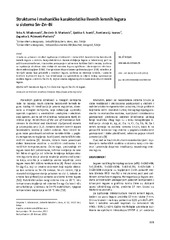Приказ основних података о документу
Strukturne i mehaničke karakteristike livenih lemnih legura u sistemu Sn-Zn-Bi
The microstructure and properties of as-cast Sn-Zn-Bi solder alloys
| dc.creator | Mladenović, Srba A. | |
| dc.creator | Marković, Desimir D. | |
| dc.creator | Ivanić, Ljubica S. | |
| dc.creator | Ivanov, Svetlana Lj. | |
| dc.creator | Aćimović-Pavlović, Zagorka S. | |
| dc.date.accessioned | 2023-01-23T11:55:32Z | |
| dc.date.available | 2023-01-23T11:55:32Z | |
| dc.date.issued | 2012 | |
| dc.identifier.issn | 0350-249X | |
| dc.identifier.uri | http://TechnoRep.tmf.bg.ac.rs/handle/123456789/5611 | |
| dc.description.abstract | U radu su prikazani rezultati ispitivanja strukturnih i mehaničkih karakteristika bezolovnih lemnih legura u sistemu kalaj-cink-bizmut. Nakon dobijanja legura u indukcionoj peći sa zaštitnom atmosferom, trostrukim pretapanjem odmerene količine čistih metala, izvršena su ispitivanja strukture tako dobijenih uzoraka legura optičkom i skenirajućom electronskom mikroskopijom (SEM). Energetskom disperzivnom spektroskopijom (EDS) određen je hemijski sastav faza prisutnih u strukturi legura. Izvršena su merenja tvrdoće, i zatezne čvrstoće ispitivanih legura. Sva istraživanja su sprovedena sa ciljem boljeg upoznavanja osobina legura u sistemu Sn-Zn-Bi, koji se smatra odgovarajućom zamenom olovnih lemnih legura. | sr |
| dc.description.abstract | Research on the lead-free solders has attracted wide attention, mostly as the result of the implementation of the Directive on the Restriction of the Use of Hazardous Substances in Electrical and Electronic Equipment. The Sn-Zn solder alloys have been considered to be one of the most attractive lead-free solders due to its ability to easily replace Sn-Pb eutectic alloy without increasing the soldering temperature. Furthermore, the mechanical properties are comparable or even superior to those of Sn-Pb solder. However, other problems still persist. The solution to overcoming these drawbacks is to add a small amount of alloying elements (Bi, Ag, Cr, Cu and Sb) to the Sn-Zn alloys. Microstructure, tensile strength, and hardness of the selected Sn-Zn-Bi ternary alloys have been investigated in this study. The SEM-EDS was used for the identification of co-existing phases in the samples. The specimens' microstructures are composed of three phases: Sn-rich solid solution as the matrix, Bi-phase and Zn-rich phase. The Bi precipitates are formed around the Sn-dendrit grains as well as around the Zn-rich phase. The amount of Bi segregation increases with the increase of Bi content. The Sn-Zn-Bi alloys exhibit the high tensile strength and hardness, but the values of these mechanical properties decrease with the increase of Bi content, as well as the reduction of Zn content. The results presented in this paper may offer further knowledge of the effects various parameters have on the properties of lead-free Sn-Zn-Bi solders. | sr |
| dc.language.iso | sr | sr |
| dc.publisher | Association of Chemical Engineers of Serbia | sr |
| dc.rights | openAccess | sr |
| dc.rights.uri | https://creativecommons.org/licenses/by/4.0/ | |
| dc.source | Hemijska industrija | sr |
| dc.subject | bezolovne legure | sr |
| dc.subject | Sn–Zn lemne legure | sr |
| dc.subject | Sn–Zn–Bi legure | sr |
| dc.title | Strukturne i mehaničke karakteristike livenih lemnih legura u sistemu Sn-Zn-Bi | sr |
| dc.title | The microstructure and properties of as-cast Sn-Zn-Bi solder alloys | sr |
| dc.type | article | sr |
| dc.rights.license | BY | sr |
| dc.citation.epage | 600 | |
| dc.citation.issue | 4 | |
| dc.citation.spage | 595 | |
| dc.citation.volume | 66 | |
| dc.identifier.doi | 10.2298/HEMIND111219015M | |
| dc.identifier.fulltext | http://TechnoRep.tmf.bg.ac.rs/bitstream/id/14743/bitstream_14743.pdf | |
| dc.identifier.scopus | 2-s2.0-84866506924 | |
| dc.identifier.wos | 000311465200018 | |
| dc.type.version | publishedVersion | sr |

